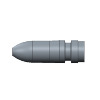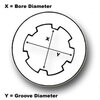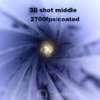Doesn't matter if the rifle cycles or not to begin with.
If it was me I'd start out with soft lead alloys and pistol powders to see what the rifle can do. A chronograph is always a good thing. You should be able to get to the 1800fps+ range with the soft alloy/pistol powders. This establishes a base line for what you're doing. From there use slower burning powders until the bullet/groups fail. Then work on the alloy to see if the groups tighten back up. If the groups tighten up do keep increasing the powder. If the groups don't tighten up with the harder alloys keep trying slower powders until you use your slowest powder.
When the groups open up and you can no longer bring them back thru alloy or powder changes you'll of reached the max of the rifle or bullet design.
A strong bullet design that is 70%+ supported by the bore is a must for hv/high pressure rounds in hp rifles.
MP silhouette bullet, It's 1" long weighs 175gr and .750" of the bullet is .308" in diameter or larger (.310") or 75% of the bullet is supported by the bore.
View attachment 973285
The band on the front of the bullet (line) is where the nose starts to taper down from the .308" body. The line in the center of the bullet is where the .308" body starts and goes to the left line at the nose. The back of the bullet has a gc shank and the 2 drive bands are .310". The bullet tapers down from .310" at the front of the front drive band to .308" at the center line. The drive bands and gc are .310" and are supported in the 308w case. The 310" to .308" tapered part of the bullet is fully supported by the throat of the chamber. The .308" bullet body is locked into the lands and is fully supported by the bbl. The mp silhouette bullet.
View attachment 973286
That bullet will easily do 2" 10-shot groups @ 100yds/2600fps+
Something else to think about:
It's a good idea to use fillers with the rifle powders in the hv cases. I use 1/4" to 3/8" square pieces of lofted dacron or poly batting. I also loft/pull/expand the squares of the dacron/poly even further. This keep the powder back in the case where it should be, by the primer with loads that are less then 85% load density.
https://www.walmart.com/ip/Fairfield-45-x-60-Poly-Fil-Extra-Loft-Batting-1-Each/17808678
Using this filler will also protect the base of the bullet. A plain based bullet with the dacron filler used to fill the case and protect the bullet's base.
View attachment 973287
Same bullet/load but this time no dacron filler was used.
View attachment 973288
Anyway start low and work up to get all the bugs worked out of casting/sizing/oal's/etc. If you can't get the rifle/bullet combo to groups @ 1600fps/1800fps then all the testing in the world doesn't matter at +/- 2400fps.











